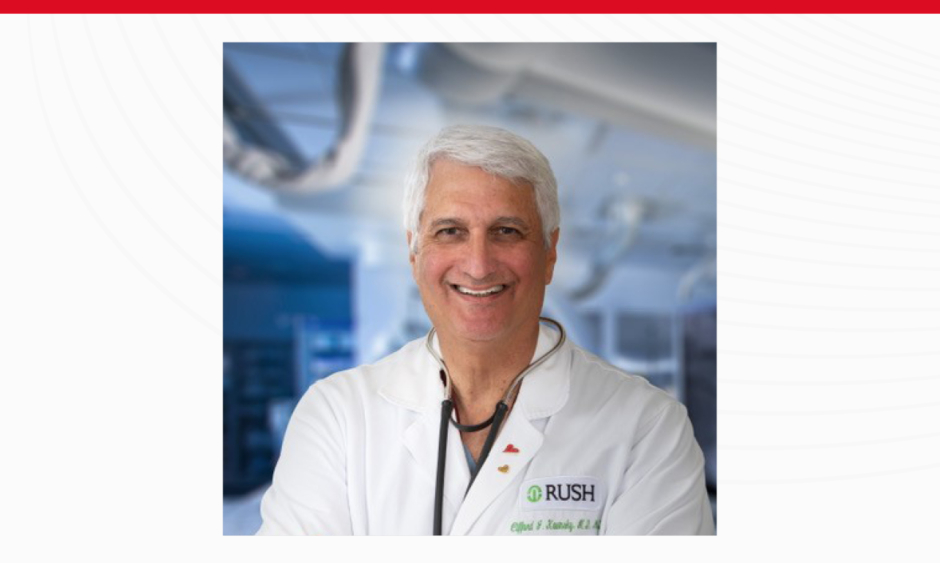Clifford Kavinsky | Associate Director of the Cardiovascular Disease Fellowship Program; Program Director for the Interventional and Structural Heart Disease Fellowship Program; Professor of the Department of Internal Medicine and Pediatrics; Chief of the Section of Structural and Interventional Cardiology; and Director of the Rush Center for Adult Structural Heart Disease at Rush University Medical College, Chicago, Illinois, USA.
![]()
Following your initial medical training, what led you to specialise in cardiology and interventional cardiology?
Initially, I felt that cardiovascular medicine afforded the greatest opportunity to take advantage of a broad array of diagnostics and therapeutic interventions that had a direct effect on patient outcomes. I thought that physical bedside assessments and cardiovascular physiology made a lot of sense, and when I treated patients, I could often see immediate and compelling results. I felt that I could have a positive effect on patients’ lives in term of longevity and quality of life and that interventional medicine represented the culmination of cardiology, allowing me to see a critically ill, unstable patient; treat their underlying problems; and watch them improve and, ultimately, go home. Whether it be performing percutaneous coronary intervention (PCI) in the setting of a ST-elevation myocardial infarction or providing mechanical circulatory support to a patient in shock, interventional medicine is extremely rewarding. We cannot save everyone, but the rewards are greater than for any other field in cardiology.
As the Associate Director of the Cardiovascular Disease Fellowship Program at Rush University Medical College, Chicago, Illinois, USA, what were your key aims when developing the structure of the programme to provide optimal training for participants?
My goal is to train cardiologists that will go out and become leaders in their field. We try to instil into our fellows the three pillars of academic medicine: excellence in patient care, the education of those following behind you, and research into new innovative treatments that will move the field of cardiovascular medicine forward. We want to expose our fellows to the entire spectrum of acute and chronic cardiovascular disease. That is why we have developed rotations at three different hospitals: a tertiary care centre, a public service hospital, and a community hospital. Each provides the trainee with different patient demographics, disease spectrums, and ways of practicing medicine. Additionally, significant time is spent fostering and mentoring fellow research involvement.
Are there any areas of the Cardiovascular Disease Fellowship Program that you have put an emphasis on or that you think are particularly important?
Health care is changing rapidly, and the training of physicians must change with it. Our focus is on shortening lengths of stay in hospitals, improving transitions in care, and providing longitudinal care. Fellow physicians do not work in isolation, but as part of a bigger multi-disciplinary care team. There are many great advances in cardiovascular medicine; however, many of these innovative therapies are expensive and the number of health care dollars entering the system is not increasing, so many hospital organisations are seeing narrowing profit margins. As physicians must be efficient in delivering the highest quality care to their patients, fellows are taught to work as part of a team to understand systems of care.
How did the COVID-19 pandemic affect the field of interventional cardiology, and are there any aspects of this shift that have now become standard practice?
For a short period of time in early 2020, interventional services for elective procedures were shut down. This policy was particularly harmful to our structural programme, where many of the procedures are elective, because we found that patients began dying at home waiting for their transcatheter aortic valve replacement (TAVR) procedures. There was also fear from the public in terms of coming to the hospital as they thought they would get COVID-19, which was fuelled by the media, so patients would not come to the hospital even when they needed to. ST-elevation myocardial infarction interventions went down, and over time, these fears have slowly been assuaged. Yet, during the recent COVID-19 surge early this year, we once again saw a drop in our interventional volumes. To date, our interventional procedural volumes have yet to achieve the pre-pandemic levels seen in 2019. In terms of precautions, all patients must have a rapid COVID-19 test within 72 hours prior to their procedures and all staff caring for patients who are COVID-19-positive and are undergoing urgent or emergent procedures must use personal protection equipment.
You recently co-authored a paper entitled ‘Percutaneous Right Ventricular Assist Device Using the TandemHeart ProtekDuo: Real-World Experience’, which was published shortly before the Joint European Association of Percutaneous Cardiovascular Interventions (EAPCI) and Association for Acute Cardiovascular Care (ACVC) consensus on percutaneous ventricular assist devices. Did you agree with the information published, and would you amend or include any additional perspectives?
I think that the ProtekDuo® catheter is the most effective percutaneous catheter-based system for providing temporary right ventricular support. It is relatively easy to place and connects to a bypass circuit. The other commercially available device on the market is the Impella RP®, which can also provide temporary support for the failing right ventricle. However, this device is more challenging to place properly due to its large size and the need for the device to track through the right atrium, right ventricle, and across the pulmonic valve.
Where does the focus of your research currently lie?
Since 2002, when Alain Cribier implanted the first percutaneous aortic valve in a human being, the major advances in interventional medicine have resided in the structural heart disease space, which is my area of focus and specialisation. The emergence of catheter-based therapies for cardiac disorders that were traditionally treated with large open cardiac surgical procedures represents a sea change in the management of patients with congenital and acquired structural heart disease. In congenital heart disease, our paediatric colleagues have done a superb job: a child now born with congenital heart disease has a >90% chance of living through to adulthood due to advances in interventional medicine. The randomised trials in TAVR have provided robust clinical data to support a paradigm shift in how we treat patients with severe aortic stenosis. The trials on patent foramen ovale (PFO) closure have finally established PFO closure as superior to medical therapy alone in preventing recurrent PFO-associated stroke. As we look forward, we will see this trend continuing. The next few years will be dedicated to developing and refining percutaneous therapies for the mitral and tricuspid valves. Transferring the success of the TAVR space to the mitral and tricuspid valves will not be easy; the mitral valve has many complexities that are not found with the aortic valve, such as its location internal to the heart, its large size, its non-planar conformation, and the associated challenges of anchoring a percutaneous valve. The tricuspid valve shares many of the same complexities. Despite these challenges, through partnership with industry, viable percutaneous technologies are emerging, and evaluating these new platforms will be my focus for the next several years. In addition, again through partnering with industry, we are trying to develop ‘no footprint’ techniques for closing a PFO without leaving a large device in the heart of patients who are young and have many years of life left to live.
Over the years you have spent practising as an interventional cardiologist, how have you seen the technology and treatment landscape develop?
It was in 1929 that Werner Forssmann cannulated his own basilic vein and advanced a urinary catheter to his right atrium, which opened up the field of invasive cardiology. I am in awe of the advances that have been made in interventional medicine since then: the emergence of coronary angioplasty, the development of the coronary stent, and, finally, the drug-eluting stent have revolutionised how we treat patients with coronary artery disease. And, as we have discussed, the emergence of catheter-based therapies for treating congenital and acquired structural heart disease has resulted in huge benefits to our patients. TAVR is now the default treatment for patients with symptomatic aortic stenosis. In 2016, there were more TAVRs performed than surgical aortic valve replacements in the USA, and these curves still continue to separate. While this trend will continue with sustained emphasis on percutaneous, non-surgical, less invasive techniques for treating our patients, this is not to say that surgery is less important. However, surgeons are increasingly asked to operate on more complex patients than they were previously, which will be a challenge for the cardiac surgery field.
Have you found that the public are generally receptive to new technologies in interventional cardiology, or do you occasionally experience resistance?
Most new technologies are usually evaluated in the context of a clinical trial. Clinical trials, particularly randomised clinical trials, require careful discussions with the patient and their family. Almost all patients will opt for the less invasive treatment strategy when offered. The early TAVR trials evaluating high, intermediate, and low risk patient subsets are randomised against surgery. It was very easy to enrol patients before the U.S. Food and Drug Administration (FDA) approval of the first TAVR valves. After FDA approval, enrolment in a randomised trial became difficult when there was a commercially available FDA-approved TAVR valve available. This is particularly true for the latest left atrial appendage closure devices, where there are now randomised trials comparing one device to another as well as against newer non-warfarin oral anti-coagulants. If a patient wants a left atrial appendage closure procedure to avoid oral anti-coagulants, why would they agree to participate in a clinical trial where they might be randomised to a treatment arm where they will just continue the medicine that they are already taking and don’t want? Instead, they will go to where a proceduralist will just implant a device commercially to be taken off of the anti-coagulants.
Are there any innovations on the horizon that you think are noteworthy, and how do you think these will impact patient quality of life?
I believe that, in another 10 years, the routine cardiac valve replacement will be largely percutaneous, with surgery reserved for more complex patients. I think that bypass surgery for coronary artery disease will be relegated to patients who cannot technically be treated with PCI, including left main disease and disease of the proximal left anterior descending coronary artery. Refinements in PCI techniques and equipment will provide the coronary interventionalist with a toolkit that will allow them to address the coronary lesions for which treatment was not possible in the past, including chronic total occlusions. The structural heart disease space will continue to expand for the next 10 years. There are several viable percutaneous mitral and tricuspid valve technologies that I think will prove effective and are poised to begin important clinical trials. We will continue to ride the wave of innovation begun by Werner Forssmann, Alain Cribier, Philipp Bonhoeffer, and Andreas Gruentzig.








